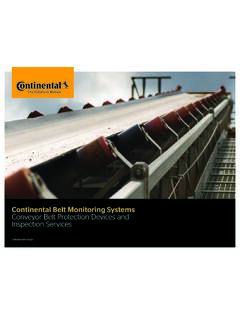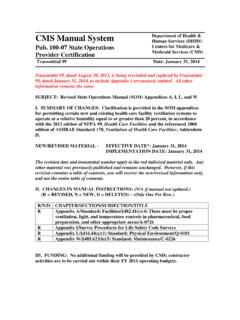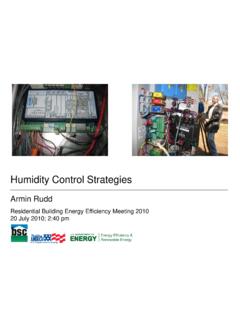Transcription of Operating Room Ventilation Systems Best Practices Guide ...
1 Operating Room Ventilation Systems Best Practices Guide for Energy Efficiency, Health and SafetyA GREENING HEALTH CARE RESEARCH PROJECTORIGINAL RELEASE: APRIL 2017 GREENING HEALTH CARE 2017 SPONSORED BY:Lead author: Ian Jarvis, , PresidentTechnical support: Farhang Vahabi, Project AnalystThis Best Practices Guide ( Guide ) is for use by Facility Directors of acute care hospitals to help evaluate their existing Operating room Ventilation Systems , and direct staff and service providers in making their Operating performance and energy efficiency the best they can be. The Guide is provided as a technical resource for Greening Health Care member hospitals. Greening Health Care is a program of the Living City managed by Toronto and Region Jarvis, President, Enerlife Consulting x 203 Operating Room Ventilation Systems Best Practices Guide for Energy Efficiency, Health and Safety | page 11.
2 Background 22. Introduction 33. Best Practices Unoccupied Setback Air Change Rates Recirculation Airflow Control monitoring and Control Control Set-points Measurement and Verification 54. Code and Regulatory Requirements 65. Pilot Hospital Findings 86. Energy Use Breakdown: Reference Ventilation system 117. system Design Configurations Reference system (no heat recovery) Thermal Wheel Heat Recovery system Glycol Coil Heat Recovery system Heat Recovery Chiller system Air Recirculation system 148. Energy Cost Comparison for Different system Design Configurations 15 Appendix A: Checklist 18 TABLE OF CONTENTSO perating Room Ventilation Systems Best Practices Guide for Energy Efficiency, Health and Safety | page 21.
3 BackgroundOperating Room (OR) Ventilation is the most energy intensive service in acute care hospitals, which in turn are one of the most energy intensive commercial/institutional building types in North America. As well, proper Ventilation is essential to the health and safety of hospital staff, surgical teams and patients. Different hospitals are designed and retrofitted with different system and control configurations, and system Operating Practices vary widely. For all these reasons, at the beginning of 2016, Greening Health Care initiated an applied research project aimed at documenting best Practices for OR Ventilation design, retrofit, operation and control, for use by member hospitals in optimizing the energy performance of their major acute care hospitals took part in the project (see sidebar), providing technical input and review as well as information on their existing Systems and operations.
4 Utility company and industry sponsors also contributed technical knowledge as well as funding for the project. Findings were presented to and reviewed at the Greening Health Care workshop on November 30th 2016, and the webinar on December 14th 2016. (See Section 5 Pilot Hospital Findings). This Best Practices Guide presents the findings, conclusions and recommendations of the General Hospital Kingston, Ontario 1,238,560 ft2 440 beds Serves 500,000 people Acute care teaching hospitalSickKids Hospital Downtown Toronto 2,840,913 ft2 across three sites average number of beds occupied daily 301,997 annual ambulatory visits Children s hospital and research facilityNorth York General Hospital North Toronto 677,691 ft2 (main hospital)
5 419 acute beds, 192 long-term beds 137,123 outpatient volume Acute care, ambulatory and long-term care servicesHumber River Hospital North Toronto 1,826,205 ft2 656 beds Serves a catchment area of more than 850,000 people Acute care hospitalAbout Greening Health CareFounded in 2003, Greening Health Care is the largest program of its kind in North America, helping hospitals work together to lower their energy costs, raise their environmental performance and contribute to the health and well-being of their communities. Members manage data, assess their performance and track savings using a powerful online system . They share knowledge and best Practices through workshops, webinars and networking to help plan, implement and verify improvements.
6 This is a program of The Living City managed by Toronto and Region Room Ventilation Systems Best Practices Guide for Energy Efficiency, Health and Safety | page 32. IntroductionDepending on local weather conditions and utility prices, a typical 25,000 cubic feet per minute (cfm) OR Ventilation system can cost as much as $125,000/year or more in electricity and thermal energy consumption. Proper design/retrofit, operation and control can reduce this cost by as much as 65%, while ensuring healthy and safe environmental conditions for surgical teams and new hospital design, this Best Practices Guide documents the energy use and utility cost implications of alternate system configurations, and lays out the Operating , control, measurement and verification requirements for optimizing in-service energy use.
7 For existing hospitals, it is generally not economic to modify the system configuration (for example, installing heat recovery or recirculation), so the Guide is intended to provide the optimal operation, control, measurement and verification Practices to get the best performance out of whatever system is Best PracticesThe individual measures for consideration with every OR Ventilation system , to be implemented where practicable, are laid out below and provided as a checklist in Appendix A. See Section 4 for required air change rates and space conditions, and Section 8 for the relative utility costs of the different design configurations and Unoccupied SetbackThe universal strategy for all system configurations is to reduce the airflow to each OR and the other areas served by the system when not in use, along with adjustments to supply air and space temperature set-points.
8 Figure 1 illustrates the requirements for implementing setback as follows: Volume control devices on the air supply and exhaust to each OR and other rooms/areas Relative pressure monitoring of the ORs against adjacent areas Occupancy sensor(s) in each room Volume control Variable Frequency Drives (VFDs) on supply and exhaust fans Space temperature reset so that reheat coils are disabled unless high or low limits are reachedOperating Room Ventilation Systems Best Practices Guide for Energy Efficiency, Health and Safety | page 4 Airflow setback during unoccupied periods reduces energy use for preheat, cooling and humidification in proportion to the airflow reduction. Fan power savings are even greater because of the affinity (cube) law, and reheat savings are proportionately greater because of reduced heat loads in the unoccupied rooms.
9 Section 8 of this Guide shows the savings due to setback for the different system design Air Change RatesTest the overall air volume and the supply to each OR, and rebalance to the required amounts as laid out in this Recirculation Operationalize air recirculation for Systems which have that capability or can be readily retrofitted. Ensure proper capture and monitoring of anesthetic gases, and that the required minimum outside air is maintained at all times when any OR is in Airflow Control Install reliable and repeatable volume control devices on the air supply to and exhaust from each individual OR. Test and calibrate for required occupied and unoccupied air volumes at least annually. Install reliable and repeatable volume control devices on the air supply to and exhaust from each other space where airflow is to be set back during unoccupied periods.
10 Test and calibrate for required occupied and unoccupied air volumes at least annually. Install airflow monitoring stations on total and outside air supply and total exhaust volumes for the air handling system . Test and calibrate at least every two 1. Setback implementation requirementsOperating Room Ventilation Systems Best Practices Guide for Energy Efficiency, Health and Safety | page monitoring and Control Install temperature and humidity sensors with continuous local and central monitoring for every individual Operating room as well as the combined exhaust air. Install occupancy and relative pressure sensors with continuous monitoring for every individual OR, and for other spaces where airflow is set back during unoccupied periods.






